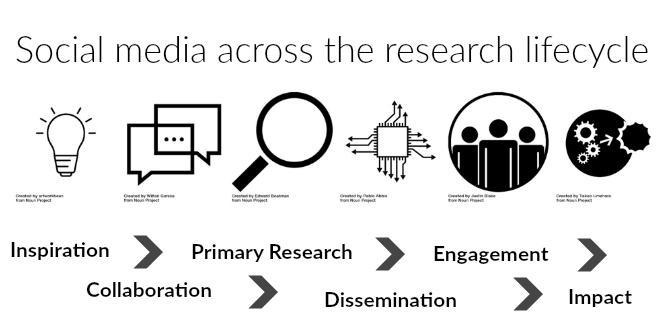Social media and the research lifestyle
Amy Mollett, Cheryl Brumley, Chris Gilson and Sierra Williams kick off a series of blog posts on the new book Communicating Your Research with Social Media. Here they present a research lifecycle framework for understanding the role of social media in research settings. The framework captures the complexity of science communication today and offers a new way to understand research’s relevance to society.
Where does social media fit in the research world? In our roles working on the frontlines of research communication, we have witnessed a great deal of optimism and legitimate backlash about researchers engaging online. Much has been written on the individual benefits and challenges of using social media (i.e. why researchers would use or not use social media platforms). But much less attention has been directed towards the research environment itself, the needs and aims of researchers (i.e. where social media fits and how it might be employed more constructively).
As researchers adopt new tools and are increasingly encouraged by institutions and funders to reach wider audiences, science communication is undergoing change. In some ways, these new media formats are replicating previous systems, and in other ways, these tools present profoundly new ways of communicating. Our fundamental aim in writing a book on social media was to combine our expertise on existing platforms and engaging content and situate these activities within the structures and changing workflows of the research environment. We wanted to explore where the aims of research and the nature of social media intersect and how they can be made to work in more cohesive and less conflictual ways.
By drawing on previous models and developments in communication and the research process, we outline six basic ‘phases’ of the 21st-century research environment: Inspiration, Collaboration, Primary Research, Dissemination, Engagement and Impact. We explore how these phases currently operate in practice and how social media is already being used in support of these activities. We argue that research has in many ways always been a social process – but especially in recent years, scientists are collaborating more with each other and with the public than ever before. To reflect this change, researchers are looking towards more suitable media and content types to facilitate these interactions.


Credit: Noun Project logos CC BY: artworkbean, Wilton Gorske, Edward Boatman, Pablo Abbis, Justin Blake, Takao Umehara
We are not the first people to talk about a lifecycle approach to the research environment and in particular we drew heavily on the work of Martin Weller, Ernest Boyer, and Bianca Kramer and Jeroen Bosman in shaping our understanding of the practices of researchers today. We look in more detail in the book at each of these distinct but overlapping phases and their role in the research process. If the research environment has evolved in ways that recognise and require a more social emphasis, then, we argue, so too should its media.
One of the difficulties of engaging with social media (and indeed, writing a book on the topic!) is just how overwhelming it can feel. There are always more tweets to read, more platforms to try and more people to follow. We took this feeling of being overwhelmed by social media’s ineffability and inescapable reach as an opportunity. The structure of our book reflects the recognition that many individuals, like us, are looking for ways to situate science communication today and deepen their understanding of research’s relevance to society. But alongside this need to understand the world, we are also looking to contribute in meaningful ways.
How can research be communicated on social media? To balance our theoretical reflection with useful guidance for practical action, we look at the different social content types useful for researchers, focusing our analysis on blogs, data visualisations, podcasts, photos and videos. Given the particular nuances and requirements of the modern-day research environment, we argue that social media is meeting very particular research needs in very particular ways. But being aware of these specific needs for your own research project will help you decide where to invest your energies and what types of digital content may be worth experimenting with. Each of our content chapters refer back to the research lifecycle, providing interviews, case studies and examples on how other researchers have created engaging content for social media in their own research practices.
Social media affords certain opportunities for researchers to explore the research process in more social ways, which may in turn help to connect research with its core social remit and commitment. Of course, it is not just opportunities. There are a number of new vulnerabilities that social media creates and exacerbates for researchers, which we do recognise. But we hope that by situating social media more explicitly in the research workflow, researchers will feel empowered to choose whether or not to engage, what expectations they can have going into it, and how to go about getting started.
Communicating Your Research with Social Media examines the role of social media in the research environment. It is a guide for researchers, students, and communications professionals looking to understand the changing landscape of research communication in the 21st century and how to create engaging social and digital media content for wider public audiences.
